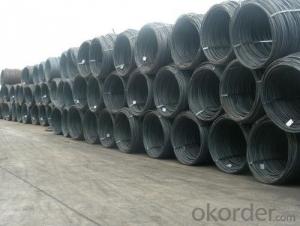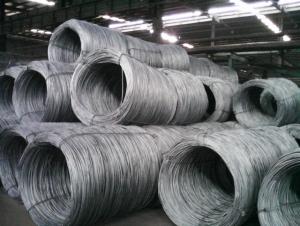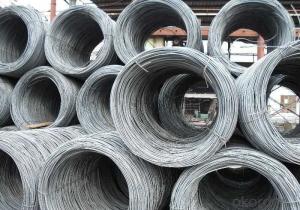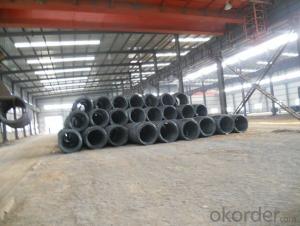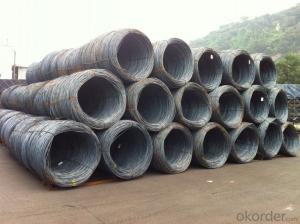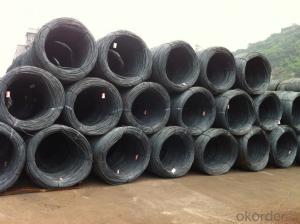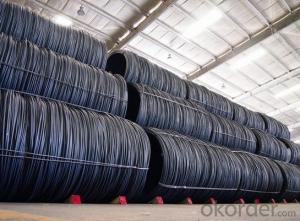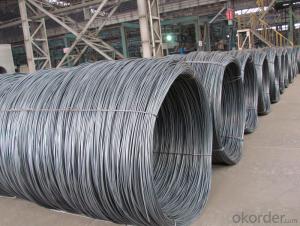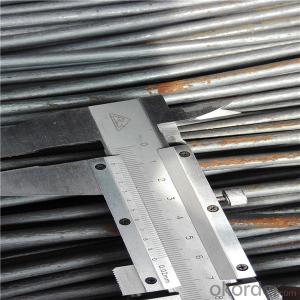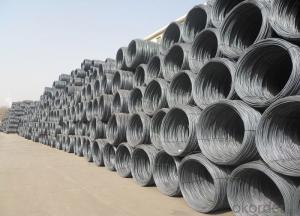Prime Hot Rolled Steel Wire Rod Low Carbon
- Loading Port:
- China main port
- Payment Terms:
- TT or LC
- Min Order Qty:
- 100 m.t.
- Supply Capability:
- 10000 m.t./month
OKorder Service Pledge
OKorder Financial Service
You Might Also Like
Specification
OKorder is offering Prime Hot Rolled Steel Wire Rod Low Carbon at great prices with worldwide shipping. Our supplier is a world-class manufacturer of steel, with our products utilized the world over. OKorder annually supplies products to African, South American and Asian markets. We provide quotations within 24 hours of receiving an inquiry and guarantee competitive prices.
Product Applications:
Prime Hot Rolled Steel Wire Rod Low Carbon are ideal for structural applications and are widely used in reinforcement of reinforced concrete and welded structure or reprocessed (roberts , nail, etc.) materials, especially used to produce wire drawing, welding electrode, nails, spring, electronic, precise machinery parts and so on.
Product Advantages:
OKorder's Prime Hot Rolled Steel Wire Rod Low Carbon are durable, strong, and wide variety of sizes.
Main Product Features:
· Premium quality
· Prompt delivery & seaworthy packing (30 days after receiving deposit)
· Can be recycled and reused
· Mill test certification
· Professional Service
· Competitive pricing
Product Specifications:
Steel Grade: Q195/235, SAE1006-1018B
Standard: ASTM, GB
Diameter: 5.5mm, 6.5mm, 7mm,8mm,9mm,10mm,12mm,14mm
Type: in coil, coil weight around 2MT
Alloy or Not: Alloy
Technique: Hot Rolled
Place of Origin: China Mainland
Surface: round, no twisted, light and smooth
Trademark | Rank | Chemical composition (quality score) % | ||||
C | Si | Mn | S | P | ||
≤ | ≤ | ≤ | ||||
Q195 | 0.06-0.12 | 0.30 | 0.25 | 0.050 | 0.045 | |
Q235 | A | 0.14-0.22 | 0.30 | 0.30-0.65 | 0.050 | 0.045 |
Q235 | B | 0.12-0.20 | 0.30 | 0.30-0.70 | 0.045 | 0.045 |
FAQ:
Q1: Why buy Materials & Equipment from OKorder.com?
A1: All products offered byOKorder.com are carefully selected from China's most reliable manufacturing enterprises. Through its ISO certifications, OKorder.com adheres to the highest standards and a commitment to supply chain safety and customer satisfaction.
Q2: How do we guarantee the quality of our products?
A2: We have established an advanced quality management system which conducts strict quality tests at every step, from raw materials to the final product. At the same time, we provide extensive follow-up service assurances as required.
Q3: How soon can we receive the product after purchase?
A3: Within three days of placing an order, we will arrange production. The normal sizes with the normal grade can be produced within one month. The specific shipping date is dependent upon international and government factors, the delivery to international main port about 45-60days.
Images:
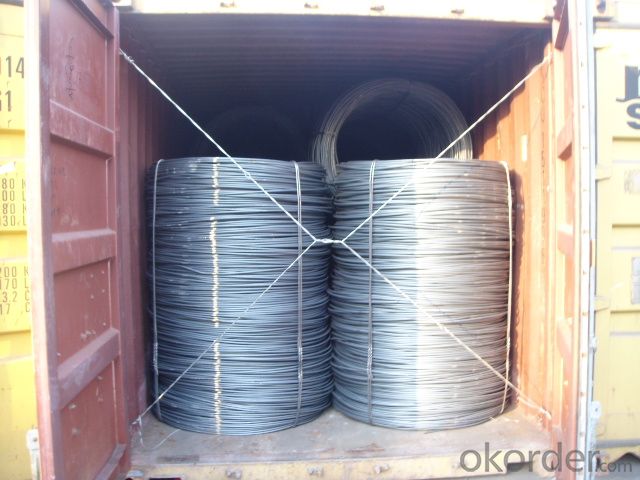
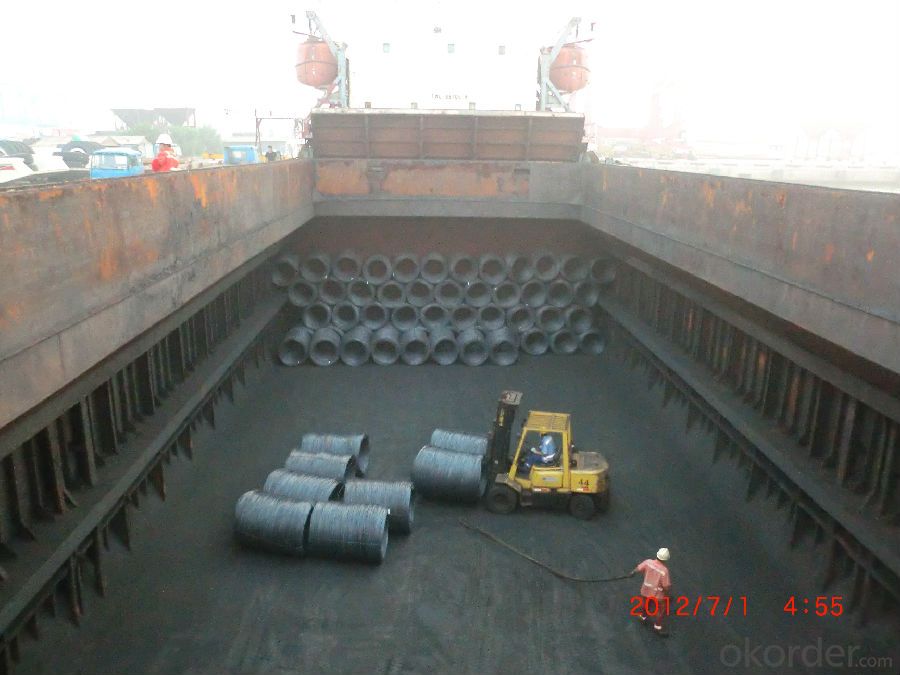
- Q: What are the different types of wire mesh made from steel wire rod?
- There are several different types of wire mesh made from steel wire rod, including welded wire mesh, woven wire mesh, expanded metal mesh, and perforated metal mesh. Each type of mesh has its own unique characteristics and applications. Welded wire mesh is made by welding individual wires together to form a grid pattern, and it is commonly used for fencing, reinforcement, and construction purposes. Woven wire mesh is created by weaving individual wires together in a specific pattern, and it is often used for filtration, screening, and decorative purposes. Expanded metal mesh is produced by cutting and stretching a metal sheet, creating a diamond-shaped pattern, and it is commonly used for grating, walkways, and security applications. Perforated metal mesh is made by punching holes in a metal sheet, and it is often used for filtration, ventilation, and facade applications.
- Q: What are the common packaging methods for steel wire rod?
- The common packaging methods for steel wire rod include coiling the rod into large coils, bundling the rod into smaller bundles, or spooling the rod onto a reel.
- Q: How is steel wire rod used in the manufacturing of wire rope turnbuckles?
- Steel wire rod is used in the manufacturing of wire rope turnbuckles as the primary material for creating the wire ropes. The wire rod is first drawn and shaped into individual wires, which are then twisted and braided together to form strong and durable wire ropes. These wire ropes are then incorporated into the construction of turnbuckles, providing the necessary tensile strength and flexibility for adjusting and securing loads in various applications.
- Q: How is steel wire rod used in the manufacturing of wire rope cables?
- Steel wire rod is used in the manufacturing of wire rope cables as it serves as the raw material for creating the individual wires that form the strands of the cable. The steel wire rod is first drawn through a series of dies to reduce its diameter and increase its tensile strength. These wires are then twisted together to form strands, which are further twisted together to create the final wire rope cable. The high strength and durability of steel wire rod make it ideal for withstanding the heavy loads and stresses that wire rope cables are commonly subjected to.
- Q: What are the storage and handling requirements for steel wire rod?
- The storage and handling requirements for steel wire rod typically include storing it in a clean and dry area to prevent rust and corrosion. It should be kept away from moisture, chemicals, and any source of potential damage. Handling should be done with proper lifting equipment to avoid any strain or damage to the material. Additionally, regular inspections should be conducted to ensure the integrity of the wire rod and any defects should be addressed promptly.
- Q: What are the different rolling processes used for steel wire rod production?
- There are several different rolling processes used for steel wire rod production, each with its own advantages and applications. 1. Hot Rolling: This is the most common and widely used method for producing steel wire rods. The process involves heating the steel billets to high temperatures and then passing them through a series of rolling mills. The hot rolling process results in a more ductile and flexible wire rod, making it suitable for various applications such as construction, automotive, and manufacturing industries. 2. Cold Rolling: Unlike hot rolling, cold rolling involves rolling the steel wire rod at room temperature. This process helps to improve the surface finish and dimensional accuracy of the wire rod. Cold rolling also enhances the mechanical properties of the wire rod, making it suitable for specialized applications like high-strength wires, springs, and electrical conductors. 3. Continuous Casting and Rolling: This method integrates the casting and rolling processes into one continuous operation. Molten steel is directly cast into thin slabs or billets, which are then rolled into wire rods without any intermediate reheating. Continuous casting and rolling offer advantages such as improved efficiency, reduced energy consumption, and enhanced product quality. 4. Microalloying Rolling: In this process, small amounts of alloying elements are added to the steel composition to improve its strength and other mechanical properties. The microalloying rolling process is commonly used for producing high-strength wire rods used in construction, infrastructure, and automotive industries. 5. Thermomechanical Rolling: This rolling process involves a combination of hot rolling and controlled cooling to achieve specific mechanical properties. By controlling the cooling rate, the microstructure of the steel wire rod can be modified, resulting in improved strength, toughness, and formability. Thermomechanical rolling is often employed in the production of high-quality wire rods for critical applications like suspension cables, ropes, and steel reinforcement. Overall, the choice of rolling process for steel wire rod production depends on factors such as the desired mechanical properties, surface finish, and application requirements. Each rolling process offers unique advantages and allows manufacturers to produce wire rods tailored to specific applications.
- Q: How is steel wire rod used in the manufacturing of wire forms for window blinds?
- Wire forms for window blinds require steel wire rod as a crucial component. This rod is chosen for its strength and durability, making it ideal for supporting the weight of blinds and enduring daily use. It is essential that the wire forms are sturdy enough to hold the blinds in place and withstand repeated opening and closing without losing their shape or functionality. To create the desired wire forms, the steel wire rod typically undergoes a series of manufacturing steps. These steps may include drawing, annealing, and coating processes. Drawing involves reducing the diameter of the rod by pulling it through dies, resulting in a thinner and more flexible wire. Annealing relieves internal stresses in the wire and enhances its ductility, making it easier to bend and shape. Coating processes may be applied to provide additional protection against corrosion or to enhance its appearance. Once the steel wire rod has been processed, it is transformed into various forms for window blinds, such as tilt rod connectors, cord connectors, and control brackets. Tilt rod connectors allow the slats in blinds to be tilted open or closed. Cord connectors secure the cords that control the raising and lowering of the blinds. Control brackets attach the blinds to the window frame and ensure stability. In summary, steel wire rod is crucial in the manufacturing of wire forms for window blinds. Its strength, durability, and versatility make it an excellent choice, ensuring the wire forms can withstand daily use and maintain functionality over time.
- Q: What are the common industry best practices for steel wire rod distributors?
- Some common industry best practices for steel wire rod distributors include maintaining a diverse and well-stocked inventory, ensuring timely delivery to customers, providing excellent customer service and technical support, adhering to quality control standards, collaborating with reputable suppliers, and staying updated on market trends and industry advancements. Additionally, distributors may engage in strategic pricing and promotional activities, invest in efficient logistics and storage facilities, and actively engage in networking and industry associations to stay connected with peers and stay informed about industry developments.
- Q: How is steel wire rod transported and stored?
- Steel wire rod is typically transported and stored using various methods. It is commonly transported in large coils or bundles, either by truck or by rail. To ensure its safety during transportation, the wire rod is often secured with straps or other fastening materials. When it comes to storage, steel wire rod is typically stored in warehouses or yards. It is important to keep the wire rod protected from moisture and other environmental factors that may cause corrosion. Therefore, it is often stored indoors or in covered areas. Additionally, the wire rod is usually stacked in neat piles or stored on racks to prevent damage and facilitate easy access. Overall, proper transportation and storage measures are crucial to maintain the quality and usability of steel wire rod.
- Q: How is steel wire rod used in the production of wire mesh for acoustic panels?
- Steel wire rod is used in the production of wire mesh for acoustic panels as it serves as the primary material for creating the mesh structure. The wire rod is typically drawn through a series of dies to obtain the desired diameter and then woven or welded together to form the wire mesh. This mesh provides the necessary support and stability to the acoustic panels, allowing sound waves to pass through while reducing noise and enhancing sound absorption.
Send your message to us
Prime Hot Rolled Steel Wire Rod Low Carbon
- Loading Port:
- China main port
- Payment Terms:
- TT or LC
- Min Order Qty:
- 100 m.t.
- Supply Capability:
- 10000 m.t./month
OKorder Service Pledge
OKorder Financial Service
Similar products
Hot products
Hot Searches
Related keywords
